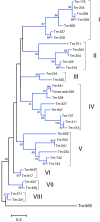An insight into the sialotranscriptome of Triatoma matogrossensis, a kissing bug associated with fogo selvagem in South America
- PMID: 22665609
- PMCID: PMC3366513
- DOI: 10.4269/ajtmh.2012.11-0690
An insight into the sialotranscriptome of Triatoma matogrossensis, a kissing bug associated with fogo selvagem in South America
Abstract
Triatoma matogrossensis is a Hemiptera that belongs to the oliveirai complex, a vector of Chagas' disease that feeds on vertebrate blood in all life stages. Hematophagous insects' salivary glands (SGs) produce potent pharmacologic compounds that counteract host hemostasis, including anticlotting, antiplatelet, and vasodilatory molecules. Exposure to T. matogrossensis was also found to be a risk factor associated with the endemic form of the autoimmune skin disease pemphigus foliaceus, which is described in the same regions where Chagas' disease is observed in Brazil. To obtain a further insight into the salivary biochemical and pharmacologic diversity of this kissing bug and to identify possible allergens that might be associated with this autoimmune disease, a cDNA library from its SGs was randomly sequenced. We present the analysis of a set of 2,230 (SG) cDNA sequences, 1,182 of which coded for proteins of a putative secretory nature.
Conflict of interest statement
Disclosure: Because TCFA, VMP, IMBF, JGV, and JMCR are government employees and this is a government work, the work is in the public domain in the United States. Notwithstanding any other agreements, the NIH reserves the right to provide the work to PubMedCentral for display and use by the public, and PubMedCentral may tag or modify the work consistent with its customary practices. You can establish rights outside of the United States subject to a government use license.
Figures



References
-
- Carcavallo RU, Jurberg J, Lent H, Galvao C, Steindel M, Carvalho Pinto CJ. A new species of the oliveirai complex (new designation for matogrossensis complex) from the State of Rio Grande do Sul, Brazil. Mem Inst Oswaldo Cruz. 2001;96:71–79. - PubMed
-
- Noireau F, dos Santos SM, Gumiel M, Dujardin JP, dos Santos Soares M, Carcavallo RU, Galvao C, Jurberg J. Phylogenetic relationships within the oliveirai complex (Hemiptera:Reduviidae:Triatominae) Infect Genet Evol. 2002;2:11–17. - PubMed
-
- Neiva A, Pinto C, Lent H. Notas sobre triatomídeos do Rio Grande do Sul e descrição de uma nova espécie. Mem Inst Oswaldo Cruz. 1939;34:607–610.
-
- Lent H, Wygodzinsky P. Revision of the Triatominae (Hemiptera:Reduviidae) and their significance as vectors of Chagas disease. Bull Am Mus Nat Hist. 1979;163:127–520.
-
- Carcavallo RU, Jurberg J, Rocha Dda S, Galvao C, Noireau F, Lent H. Triatoma vandae sp.n. of the oliveirai complex from the State of Mato Grosso, Brazil (Hemiptera: Reduviidae: Triatominae) Mem Inst Oswaldo Cruz. 2002;97:649–654. - PubMed
Publication types
MeSH terms
Substances
Supplementary concepts
Grants and funding
LinkOut - more resources
Full Text Sources
Medical

